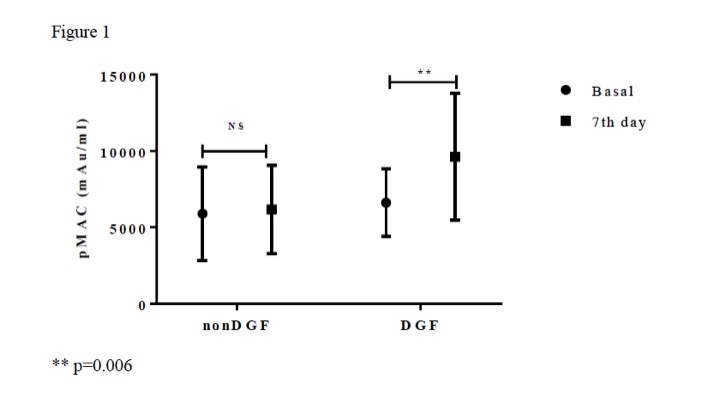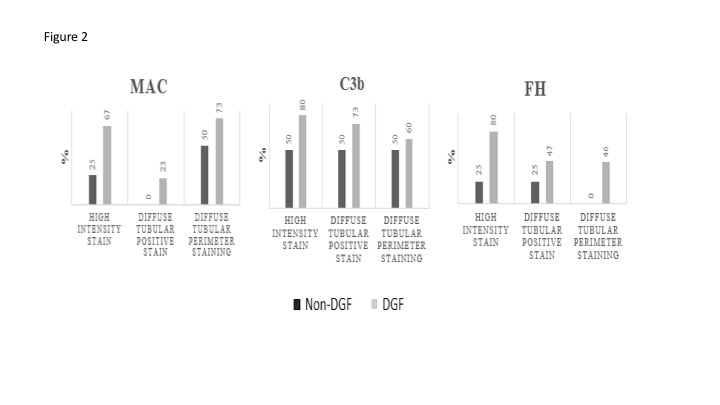Complement Activation and Delayed Graft Function after Kidney Transplantation
1Nephrology, Hospital Del Mar, Barcelona, Spain, 2Pathology, Hospital Del Mar, Barcelona, Spain
Meeting: 2020 American Transplant Congress
Abstract number: A-318
Keywords: Ischemia, Kidney transplantation
Session Information
Session Name: Poster Session A: Biomarkers, Immune Assessment and Clinical Outcomes
Session Type: Poster Session
Date: Saturday, May 30, 2020
Session Time: 3:15pm-4:00pm
 Presentation Time: 3:30pm-4:00pm
Presentation Time: 3:30pm-4:00pm
Location: Virtual
*Purpose: Ischemia-reperfusion (I/R) damage is the most important cause of delayed graft function (DGF), which has a negative impact on kidney transplant (KT) outcomes. Complement activation is involved in I/R injury pathophysiology, but most of these data come from animal’s models and there are few data are available from KT patients. We aimed to evaluated the dynamic to complex membrane attack complex (MAC) as soluble plasma fraction (pMAC) and the histological deposit pattern to C3b, complement inhibitor factor H (FH) and MAC in DGF patients.
*Methods: We evaluated plasma MAC (pMAC) levels in 59 KT recipients, 38 with immediate graft function and 21 without serum creatinine decreased on day 7 (DGF). pMAC was measured at admission for KT (day 0) and 7 days after KT (day 7). Sandwich ELISAs were used to measure MAC. Additionally, we stained for MAC, C3b and FH 15 kidney biopsies (KB) with DGF and a control group of one-year protocol biopsies without damage (n=5).
*Results: Plasma MAC levels (pMAC) increased significantly in DGF patients (day 0: 6621±2202 mAu/L vs day 7: 9626±4142 mAu/L; p=0.006), while remaining stable in non-DGF patients (day 0: 5902±3049 mAu/L vs day 7: 6178±2882 mAu/L; p=0.686) [Figure 1]. A receiver operating characteristic curve analysis identified a percentage increase from day0 to day7, higher than 5% as the better cut-off for to distinguis DGF and non-DGF patients , with a sensitivity of 81%. pMAC increase was related with the duration of DGF. Multivariate analysis showed an independent association between DGF and pMAC increase between day0 and day 7. MAC, C3b and FH stain was observed in tubular epithelial cell basal membrane. Biopsies from DGF patients showed with more frequency high-intensity stain, a larger number of tubules with positive stain and larger perimeter of tubules with positive satin for MAC, C3b and FH than the controls. Figure 2
*Conclusions: In this study, plasma MAC levels and MAC, C3b and FH deposits in tubular epithelial cell basal membranes are highly expressed in DGF patients. This finding could have therapeutic implications
To cite this abstract in AMA style:
Arias-Cabrales C, Pérez-Sáez M, Riera M, Gimeno J, Benito D, Redondo-Pachón D, Buxeda A, Burballa C, Crespo M, Pascual J, Rodríguez E. Complement Activation and Delayed Graft Function after Kidney Transplantation [abstract]. Am J Transplant. 2020; 20 (suppl 3). https://atcmeetingabstracts.com/abstract/complement-activation-and-delayed-graft-function-after-kidney-transplantation/. Accessed July 1, 2025.« Back to 2020 American Transplant Congress


